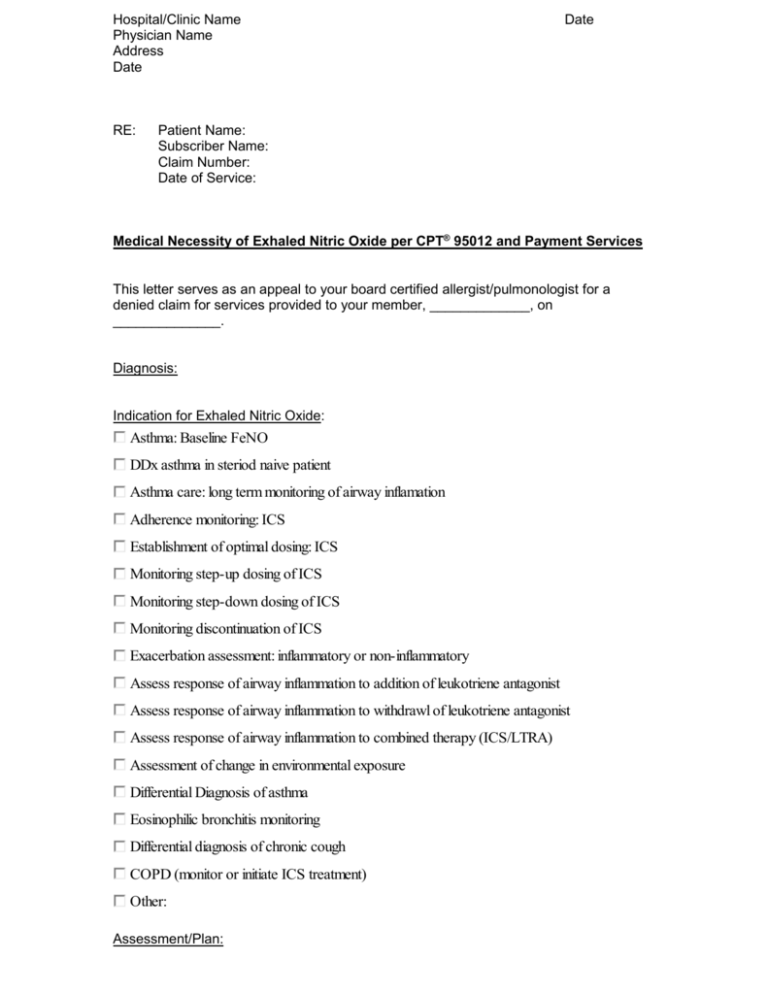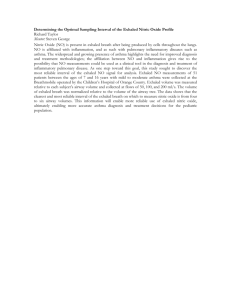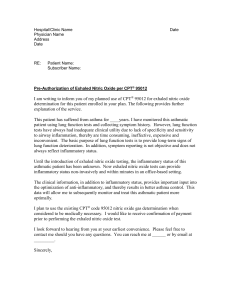
Hospital/Clinic Name
Physician Name
Address
Date
RE:
Date
Patient Name:
Subscriber Name:
Claim Number:
Date of Service:
Medical Necessity of Exhaled Nitric Oxide per CPT® 95012 and Payment Services
This letter serves as an appeal to your board certified allergist/pulmonologist for a
denied claim for services provided to your member, _____________, on
______________.
Diagnosis:
Indication for Exhaled Nitric Oxide:
Asthma: Baseline FeNO
DDx asthma in steriod naive patient
Asthma care: long term monitoring of airway inflamation
Adherence monitoring: ICS
Establishment of optimal dosing: ICS
Monitoring step-up dosing of ICS
Monitoring step-down dosing of ICS
Monitoring discontinuation of ICS
Exacerbation assessment: inflammatory or non-inflammatory
Assess response of airway inflammation to addition of leukotriene antagonist
Assess response of airway inflammation to withdrawl of leukotriene antagonist
Assess response of airway inflammation to combined therapy (ICS/LTRA)
Assessment of change in environmental exposure
Differential Diagnosis of asthma
Eosinophilic bronchitis monitoring
Differential diagnosis of chronic cough
COPD (monitor or initiate ICS treatment)
Other:
Assessment/Plan:
Asthma is defined as a chronic inflammatory process which leads to airflow limitation
and increased responsiveness to asthma triggers. Standard methods for diagnosing
and monitoring asthma traditionally focus on symptoms and airway constriction. Until
now, routine assessment of the underlying level of inflammation has not been possible.
Today a substantial amount of data exists to confirm the clinical value of exhaled nitric
oxide. The American Thoracic Society (ATS) has published guidelines for the
standardization of exhaled nitric oxide measurement1. In addition, the NHLBI asthma
guidelines state that there is a positive role for exhaled nitric oxide measurement as an
inflammatory marker2. More than 1500 publications in peer reviewed journals establish
NO as the most effective marker of airway inflammation.
Exhaled NO improves diagnostic accuracy3-6: The levels in asthmatics are 2-6
times higher, thereby identifying eosinophilic asthma in symptomatic patients
which minimizes inappropriate or ineffective therapy.
Exhaled NO predicts anti-inflammatory response7,8, 9: Steroid response can be
expected in patients with an ongoing eosinophilic inflammation. Exhaled NO can
be used for immediate and non-invasive identification of steroid responsiveness.
Patient with normal Exhaled NO values and no symptomatic response to antiinflammatory treatment may not have an underlying inflammation.
Exhaled NO determines the best treatment for chronic cough10: Patients with an
elevated exhaled NO value and chronic cough are likely to respond positively to
inhaled corticosteroids, while those with normal values are unlikely to respond.
Exhaled NO values, low and high, are of clinical significance11: There is improved
management and general practitioner diagnostic confidence when treating
patients presenting with non-specific respiratory symptoms.
Exhaled NO improves the patient’s understanding of their airway disease, and
improves compliance12-17: Exhaled NO values change rapidly depending upon
anti-inflammatory treatment intake or allergen exposure, therefore elevated NO
values in patients taking maintenance doses of inhaled corticosteroids
determines whether or not the patient is adhering to the therapy prescribed, has
a poor inhalation technique, is still exposed to allergens, or has been prescribed
enough anti-inflammatory therapy.
Exhaled NO is cost effective18: Both healthcare costs for unscheduled patient
visits due to loss of asthma control and the cost of inhaled corticosteroids are
reduced.
Exhaled NO optimizes dose adjustments19: Steroid dose titration according to the
patient’s needs is possible with the routine monitoring of exhaled nitric oxide.
Exhaled NO predicts asthma relapse20: When asymptomatic children in clinical
remission stopped taking steroids, an exhaled NO value ≥49 ppb, 2-4 weeks later
is an effective predictor of asthma relapse.
Please feel free to contact me (Tel nr, email) for further discussion or with any questions.
Best Regards,
, MD
Department of
Hospital/Clinical Name
References:
1. ATS/ERS recommendations for standardized procedures for the online and offline
measurement of exhaled lower respiratory nitric oxide and nasal nitric oxide, 2005. Am J
Respir Crit Care Med. 2005 Apr 15;171(8):912-30.
2. NHLBI National Heart, Lung and Blood Institute. Expert Panel Report 3: Guidelines for the
diagnosis and management of asthma—full report 2007. August 28, 2007. Available at:
www.nhlbi.nih.gov/guidelines/asthma/asthgdln.pdf.
3. Dressel H, de la Motte D, Reichert J, Ochmann U, Petru R, Angerer P, Holz O, Nowak D,
Jörres RA, Exhaled nitric oxide: Independent effects of atopy, smoking, respiratory tract
infection, gender and height. Resp. Med. 2008 Jul;102(7):962-9.
4. Malmberg LP, Petays T, Haahtela T, et al. Exhaled nitric oxide in healthy nonatopic schoolage children: determinants and height-adjusted reference values. Pediatr Pulmonol 2006;
41: 635-42.
5. Smith AD, Cowan JO, Filsell S, McLachlan C, Monti-Sheehan G, Jackson P, Taylor DR.
Diagnosing asthma – Comparisons between exhaled nitric oxide measurements and
conventional tests. Am J Respir Crit Care Med 2004;169:473-8.
6. Malmberg LP, Pelkonen AS, Haahtela T, Turpeinen M. Exhaled nitric-oxide rather than lung
function distinguishes preschool children with probable asthma. Thorax 2003;58:494-9.
7. Smith AD, Cowan JO, Brassett KP, Filsell S, McLachlan C, Monti- Sheehan G, Herbison GP,
Taylor DR. Exhaled nitric oxide: a predictor of steroid response. Am J Respir Crit Care Med
2005;172:453-9.
8. Zeiger RS, Szefler SJ, Phillips BR, Schatz M, Martinez FD, Chinchilli VM, Lemanske RF Jr,
Strunk RC, Larsen G, Spahn JD, Bacharier LB, Bloomberg GR, Guilbert TW, Heldt G,
Morgan WJ, Moss MH, Sorkness CA, Taussig LM; CARE Network of the NHLBI. Response
profiles to fluticasone and montelukast in mild-to-moderate persistent childhood asthma. J
Allergy Clin Immunol. 2006 Jan;117(1):45-52.
9. Bratton DL, Lanz MJ, Miyazawa N, White CW, Silkoff PE. Exhaled nitric oxide before and
after montelukast sodium therapy in school-age children with chronic asthma: A preliminary
study. Pediatr Pulmonol 1999;28:402-407.
10. Hahn PY, Morgenthaler TI, Lim KG. Use of exhaled nitric oxide in predicting response to
inhaled corticosteroids for chronic cough. Mayo Clin Proc 2007; 82: 1350–5.
11. Hewitt RS, Modrich CM, Medlicott T, Cowan JO, Taylor DR. Supporting the diagnosis of nonspecific respiratory symptoms in primary care: the role of exhaled Nitric Oxide measurement
and spirometry. Prim Care Respir J; 2008 Apr; 17(2):97-103.
12. Silkoff PE, et al. The Aerocrine exhaled nitric oxide monitoring system NIOX is cleared by
the US Food and Drug Administration for monitoring therapy in asthma. J Allergy Clin
Immunol 2004;114:1241-56.
13. Sorkness CA, Lemanske RF, Jr., Mauger DT, et al. Long-term comparison of 3 controller
regimens for mild-moderate persistent childhood asthma: The Pediatric Asthma Controller
Trial. J Allergy Clin Immunol 2007; 119: 64-72.
14. Piacentini GL, Bodini A, Costella S, et al. Allergen avoidance is as sociated with a fall in
exhaled nitric oxide in asthmatic children. J Allergy Clin Immunol 1999;104:1323-4.
15. Delgado-Corcoran C, Kissoon N, Murphy SP, Duckworth LJ. Exhaled nitric oxide reflects
asthma severity and asthma control. Pediatr Crit Care Med 2004 Vol.5, No.1.
16. Stirling RG, Kharitonov SA, Campbell D, et al. Increase in exhaled nitric oxide levels in
patients with difficult asthma and correlation with symptoms and disease severity despite
treatment with oral and inhaled corticosteroids. Asthma and Allergy Group. Thorax
1998;53:1030-4.
17. Payne DN, Wilson NM, James A, Hablas H, Agrafioti C, Bush A. Evidence for different
subgroups of difficult asthma in children. Thorax 2001;56:345-50.
18. Berg J, Lindgren P. Economic evaluation of FENO measurement in diagnosis and 1-year
management of asthma in Germany. Respir Med 2008; 102: 219–31.
19. Smith AD, Cowan JO, Brassett KP, Herbison GP, Taylor DR. Use of Exhaled Nitric Oxide
Measurements to Guide Treatment in Chronic Asthma. N Engl J Med 2005;352:2163-73.
20. Pijnenburg MW, Hofhuis W, Hop WC, De Jongste JC. Exhaled nitric oxide predicts asthma
relapse in children with clinical asthma remision. Thorax 2005;60:215-8.
Physician’s Current Procedural Terminology (CPT®) codes, descriptions and two-digit numeric
modifiers are copyright ©2007 American Medical Association. All Rights Reserved.







